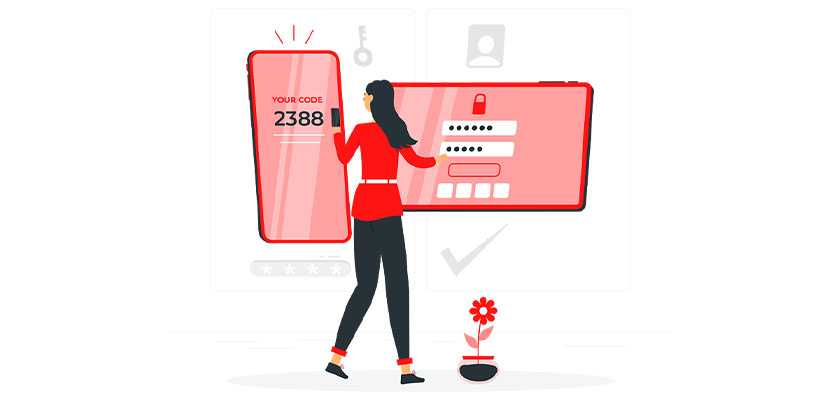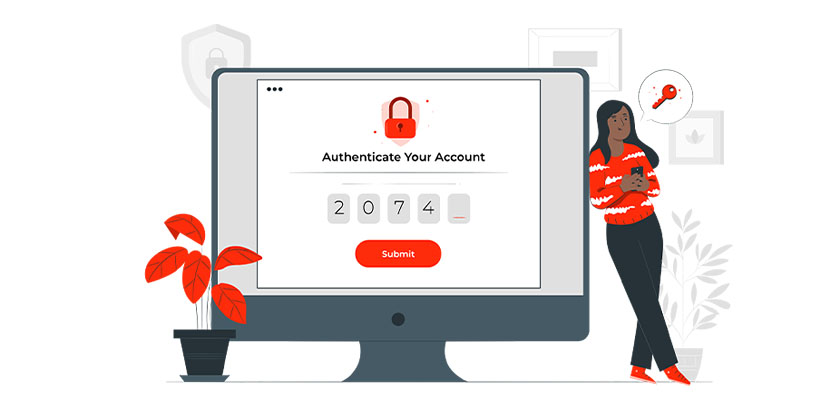
Two-factor authentication within WordPress is becoming more well-known as webmasters look for new ways to protect their websites from unwanted intrusion. There are a variety of great ways to put WordPress 2FA set up.
There are a variety of excellent ways to increase your WordPress website security, like buying secure WordPress hosting; however, two-factor authentication on WordPress is one that is getting more attention. You need to add WordPress two-factor authentication without a plugin or with a plugin for your website’s security.
What’s Two-Factor Authentication?
Simply stated, 2FA is an additional layer of security that helps to ensure that anyone trying to access accounts online is the person they claim to be. It works with smartphones. A user needs to confirm at least one reliable number before registering for 2FA.
Apple iOS, Google Android, along with Windows 10 all have apps that can support 2FA. This means that it permits the phone to act as a physical device to fulfill the authentication requirement. It is able to work in a way that users are asked to input the six-digit code.
After a user has entered an email address and name, they will then be asked for a second item of information to prove that they are the person they claim they are. The second element could be one among the following:
- PIN Number
- Passwords
- Secret Questions
- Something You Own (credit card phone, credit card hardware token)
- Fingerprint
- Iris Scan
- Voice Print
The final three are more sophisticated, but they can be set up when necessary if you have a piece of equipment that can support these features.
In this article, we’ll discuss how to install two-factor authentication in WordPress with the plugin. But how can two-factor help you with WordPress website security?
The Importance of Two-Factor Authentication
If you look at the leading CMS platforms like Joomla!, Drupal, and Magento, WordPress is leading with a 65.1% market share. Because of its popularity, this means that it’s more vulnerable to attack than the other CMS’ mentioned. There is no way to prove that one is more secure than the others. Most attacks happen due to the sheer number of websites that are available.
Another reason could be due to inexperienced webmasters. WordPress has always been a great platform because virtually everyone can learn about it and start using it; however, that also means that there are many novices who leave the back doors open by not patching or not blocking things with the proper permissions, etc.
WordFence security plugin conducted a survey with a lot of WordPress site owners in 2016 and asked them to respond to one of the following questions: “If you know how your site was compromised, please describe how the attackers gained access.” 61.5% said they didn’t know how attackers got access to their site.
The company also conducted a survey to determine what attackers are doing with compromised WordPress websites. It is evident that 25% of WordPress sites are removed from the site or have their logos changed. This is one of the most disastrous things that can occur if you manage your own WordPress business. This is why you should start with security measures before you implement any other security measures.
There are numerous ways to secure your WordPress site. One simple alteration is to change the WordPress password URL. This can instantly reduce the number of unsuccessful login attempts that you face to your WordPress website from bots and scripts that are constantly searching the internet for ways to gain access. One essential factor is to pick a strong password.
Doesn’t sound too difficult, does it? So, take a look at SplashData’s annual list of the most well-known passwords that have been stolen over the course of the year (sorted by popularity).
- 123456
- Password
- 123456789
- 12345678
- 12345
- 111111
- 1234567
- sunshine
- Qwerty
- iloveyou
It’s true! The most used password you can use is “123456”, followed by an awe-inspiring “password”.
Security begins with the fundamentals. Google provides some excellent suggestions regarding how to select an effective password. One of their recommendations is to allow free two-factor authentication.
Two-factor authentication is a two-step process where you do not require only your password for login but also another method to log in. It’s typically in the form of text (SMS) or a phone call, or a single-time password (TOTP). Most of the time, this method is 100% efficient in stopping the use of brute force to attack your WordPress website. Why? Because it’s almost impossible for an attacker to possess both your password as well as your mobile phone.
2FAS Light Google Authenticator
With secure WordPress hosting and 2FAS Light Google Authenticator, which is a smooth, user-friendly and simple-to-set-up plugin that lets you include WordPress two-factor security to your website. It works by requiring users to utilize Google Authenticator mobile app to authenticate their identity.
This is a totally free 2FA solution for WordPress and is also compatible with other mobile applications which generate tokens, such as Microsoft Authenticator, Authy, Free OTP, 2STP, and OTP Auth. In the end, it’ll be difficult to find a more effective two-factor authentication solution for WordPress that’s as robust as this and cost-free to use.
Another advantage of the plugin is you do not be required to sign up or establish any accounts with third parties. The only thing you need is to install it, enable it and then set it up to use it. After that, you’re good to go.
Install Two-Factor Authentication on WordPress

1. Install the plugin and activate the Plugin
Before you can utilize WordPress 2FA Google Authenticator, you must first be able to set up and then activate the plugin called 2FAS Light. This can be done by visiting the Plugins page within your WordPress administrator dashboard.
Simply use the search box on the page and then search for the plugin’s name. When you see it pop up then, install it, and then activate it from there.
After the plugin is activated and installed, it is time to go to the main configuration page. To complete this process, you need to click the “2FAS Light” link tab, which is located on the left-hand side of the menu in the Dashboard.
It’s obvious that the option has appeared since you enabled the plugin. This will lead you directly to the main page for configuration. From there, you are able to configure the plugin and have it up and running on your website.
First, you’re required to download an application for your phone.
2. Install the appropriate Application to Your Smartphone
Install the right app for your phone. It is your choice, the one you prefer. However, it is recommended to use the Google Authenticator app, or the 2FAS Authenticator app is the one that’s recommended. Both are easy to use and easy to scan.
3. Scan the QR Code
After you’ve downloaded the application of your choice, you can now look up the QR code provided. Click on the “Show QR Code” button and scan the screen that displays. The app will be used for scanning the QR code.
4. Enter the 6-Digit Code
After you have scanned your QR Code box from the previous step, a six-digit token will be displayed on your phone. You can copy and paste the token into the box and then click the “Add Device” button.
That’s it! Now you will receive confirmation that 2FA is configured and activated for your device. You are now already.
You are able to add more secure devices if you require them. At this moment, two-factor authentication on WordPress is in place and working. When users attempt to sign into the website using 2FA, an additional authentication process will be required.
Conclusion
In this article, we discussed how to install a free two-factor authentication WordPress plugin and how you can increase your WordPress security. There are many methods, like buying secure WordPress hosting and installing various security plugins in WordPress. Installing two-factor authentication in WordPress isn’t an issue in any way. It is just a matter of knowing the tools to utilize and how to make use of it. 2FAS Light plugin makes the job simple and quick If you’re in search of an additional layer of security, this is the method to take.
We hope that this guide helped you understand how easy it could be for you to include an additional layer of security to your website by using 2FA. Just install the plugin mentioned above. Follow the steps, and you’ll be ready to go.
Frequently Asked Question – Add Two-Factor Authentication in WordPress
Does WordPress allow two-factor authentication?
Absolutely, WordPress can support two-factor security (2FA). WordPress provides two-factor authentication via different plugins, like Google Authenticator, Duo Two-Factor Authentication and WordPress 2FA.
What is the 2FA code in WordPress?
2-factor authentication (two-factor security) is another layer of security that protects WordPress account users from unauthorized access. If enabled, 2FA requires a user to present two forms of identification to sign into their account. Usually, something they are familiar with (such as the password) and something they already have (such as a number generated via an app or sent by SMS).
How can I add 2FA to my WordPress website?
To incorporate 2FA into the security of your WordPress site, you may make use of the plugin. There are many paid and free plugins that can add 2FA capabilities to your login procedure. A popular and well-known plugin is Google Authenticator – Two Factor authentication (2FA). Once you have installed the plugin, you’ll have to set the plugin’s preferences and also scan QR codes on your smartphone to enable 2FA.
How do I set up an authenticator 2-step verification?
To enable the authenticator 2-step verification, you’ll have to:
- Install an authenticator application on your device or smartphone (such as Google Authenticator or Microsoft Authenticator)
- Log into your account on the site or application you wish to enable 2-step verification.
- Access two-step verification or security settings on that account.
- Follow the steps to create an authenticator new to the system or scan the QR Code supplied on the app or website using your authenticator app.
- Input the code for verification generated by the authenticator application to confirm that the 2-step verification has been properly configured.










Leave a Reply